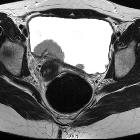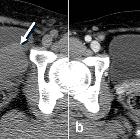Harnblasenkarzinom
 ähnliche Suchen
ähnliche Suchen siehe auch
siehe auchBladder cancer is a broad term used to describe all types of cancers affecting the urinary bladder:
- transitional cell carcinoma (urinary bladder): most common primary neoplasm of the bladder
- squamous cell carcinoma (urinary bladder): accounts for around 3-8% of all bladder cancers
- adenocarcinoma (urinary bladder): accounts for around 1% of all bladder cancers
- small cell carcinoma (urinary bladder): extremely rare
Staging
The Vesical Imaging-Reporting and Data System (VI-RADS) scoring system was created in 2018 to standardize imaging and reporting of bladder cancer staging with multiparametric MRI .
Siehe auch:
- Urothelkarzinom
- Urachuskarzinom
- Neoplasien der Blase
- Lymphom Harnblase
- Plattenepithelkarzinom der Harnblase
- Blasentumoren bei Kindern
- Rhabdomyosarkom der Blase
- Transitionalzellkarzinom der Blase
und weiter:
 Assoziationen und Differentialdiagnosen zu Harnblasenkarzinom:
Assoziationen und Differentialdiagnosen zu Harnblasenkarzinom:





















